
About UsThe Numismatic Bibliomania Society is a non-profit organization promoting numismatic literature. For more information please see our web site at coinbooks.org SubscriptionsThose wishing to become new E-Sylum subscribers (or wishing to Unsubscribe) can go to the following web page link MembershipThere is a membership application available on the web site Membership Application To join, print the application and return it with your check to the address printed on the application. Membership is only $15 to addresses in the U.S., $20 for First Class mail, and $25 elsewhere. For those without web access, write to: David M. Sundman, Secretary/TreasurerNumismatic Bibliomania
Society AsylumFor Asylum mailing address changes and other membership questions, contact David at this email address: dsundman@LittletonCoin.com SubmissionsTo submit items for publication in The E-Sylum, just Reply to this message, or write to the Editor at this address: whomren@coinlibrary.com
BUY THE BOOK BEFORE THE COINYou won't regret it! |
- WAYNE'S WORDS: THE E-SYLUM MAY 12, 2013
- KOLBE & FANNING ANNOUNCE SALE OF KREINDLER LIBRARY
- ANS LIBRARY DUPLICATE SALE
- NEW BOOK: U.S. COIN DIGEST 2014
- NEW BOOK: PANIC SCRIP OF 1893, 1907 AND 1914
- REVIEW: COIN COLLECTING MAGAZINE
- ARCHIVES INTERNATIONAL JUNE 4TH, 2013 AUCTION
- STACK FAMILY INGOT DONATIONS TO THE NATIONAL NUMISMATIC COLLECTION
- MORE ON JOHN C. LIGHTHOUSE
- NOTES FROM E-SYLUM READERS: MAY 12, 2013
- SCOVILL SUBJECT OF MUSEUM ORAL HISTORY PROJECT
- SOME ROOSTER COUNTERSTAMPS
- THE PLACE OF FAKES IN NUMISMATICS
- HARVEY STACK ON THE DAVIS-GRAVES COLLECTION, PART III
- MAGICAL NUMISMATICS: THE SILVER SHILLING
- MOVIE REVIEW: WHO’S MINDING THE MINT?
- LOOPY LEW'S PENMANSHIP PROGRESS
- MORSE CODE ON MONEY
- KEN POTTER ON DIES AND MINTING
- BUDGET CUTS IMPACT LIBRARY OF CONGRESS
- THE DIAMOND SUTRA
- MORE ON THE SEDE VACANTE COINS
- ROBOTS IN NUMISMATICS
- THE ROYAL AUSTRALIAN MINT'S NEW TRIANGULAR COIN
- ORANIA: SOUTH AFRICAN ENCLAVE HAS LOCAL CURRENCY
- BOB EVANS ON THE LATEST S.S. CENTRAL AMERICA ARTICLE
- THE DAVID FORE COLLECTION PART TWO
- GERMAN CHILDREN USING INFLATION MONEY AS BUILDING BLOCKS
- FEATURED WEB PAGE: THE NUMISMATIC MALL
WAYNE'S WORDS: THE E-SYLUM MAY 12, 2013

We have no new subscribers this week. We currently have 1,649 email subscribers, plus 232 followers on Facebook.
This week we open with notes from literature dealers Kolbe-Fanning and ANS Librarian Elizabeth Hahn, followed by information on a couple new books. Other topics include the J. C. Lighthouse, Davis-Graves and David Fore collections, and the Scovill company.
To learn more about Herbert Kreindler, Harvey Stack's ingot collection, rooster counterstamps, Orania's local currency, and robots and 3D printing in numismatics, read on. Have a great week, everyone!
Wayne Homren
Editor, The E-Sylum
KOLBE & FANNING ANNOUNCE SALE OF KREINDLER LIBRARY
Kolbe & Fanning Numismatic Booksellers are extremely pleased to announce that they will be offering at public auction the outstanding and comprehensive library on ancient numismatics formed over decades by New York coin dealer Herbert Kreindler. Highlights from the library, featuring many extraordinary works, will be sold in conjunction with the New York International Numismatic Convention on Saturday, January 11, 2014 at the Waldorf-Astoria Hotel in New York City. The sale will be held in association with Fritz Rudolf Künker GmbH, of Osnabrück, Germany, and will be followed, several days later, by an eLive online auction featuring the remainder of the library.
The Kreindler library is well-known for its extensive nature, including original editions of virtually all of the key works on ancient Greek and Roman coins. Works on the coins of the Holy Land are well represented, and the collection of classic auction catalogues must rank as one of the finest offered in recent years. The library is replete with rare and desirable volumes, many of which are finely bound. Among the highlights of the library are complete original sets of all of the major European numismatic periodicals featuring content relevant to the scope of the library. Among them are excellent sets of the Numismatic Chronicle, Numismatische Zeitschrift, Revue numismatique, Rivista Italiana, Zeitschrift für Numismatik, and others.
Herb Kreindler has been a professional numismatist since the early 1970s and has long recognized the importance of a numismatic library to anyone seriously pursuing the subject as either avocation or vocation. His library reflects years of careful and patient effort, and its offering at public auction promises to be a most exciting bibliophilic event.
Parties interested in viewing the library before it is prepared for shipment should contact Herb Kreindler at (631) 427-0732. Books will also be available for viewing at Kolbe & Fanning’s offices in Gahanna, Ohio once cataloguing is completed later in the year, and also in the days before the sale in New York City.
Kolbe & Fanning can be reached at df@numislit.com and by phone at +1 (614) 414-0855. The firm’s website can be reached at www.numislit.com.
ANS LIBRARY DUPLICATE SALE


ANS Library duplicate items for sale (new items added!) New items have been added to the list of duplicate items from the ANS library that are available for purchase. Prices do not include shipping fees, which can be available upon request. Please remember that all proceeds will benefit the library budget!
The full list is available online: numismatics.org/Library/LibraryDuplicates
Additional titles are also available at the American Numismatic Society Amazon Store: www.amazon.com/shops/American_Numismatic_Society
NEW BOOK: U.S. COIN DIGEST 2014
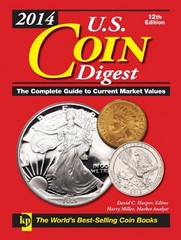 U.S. Coin Digest is the most complete and comprehensive color guide to all circulating and non-circulating U.S. coins, from early American Token Coinage to modern commemorative issues of the 21st century. This color reference is perfect for the beginner or the expert and remains the #1 tool for U.S. coin dealers and researchers.
U.S. Coin Digest is the most complete and comprehensive color guide to all circulating and non-circulating U.S. coins, from early American Token Coinage to modern commemorative issues of the 21st century. This color reference is perfect for the beginner or the expert and remains the #1 tool for U.S. coin dealers and researchers.
Fully illustrated with pricing in 11 grades of condition, the 12th edition of U.S. Coin Digest is an ideal product for anyone looking for a handy, portable price guide. The book's concealed wire-o binding allows the book to open and lay flat on a table, creating the perfect "hands-free" tool for researching and pricing.
- High-quality images make for easy and accurate identification to all U.S. coin issues
- Features thousands of accurate and completely vetted coin prices by editor David C. Harper and pricing analyst Harry Miller, both highly respected authorities in the field
- Hard cover, concealed wire-o binding allows book to open and lay flat on a table, creating the perfect "hands-free" tool for researching and pricing
For more information visit www.sellcoinbooks.com/us-coin/2014-u-s-coin-digest .
NEW BOOK: PANIC SCRIP OF 1893, 1907 AND 1914
I was updating my Amazon wish list for numismatic titles and found this. I know that I particularly enjoy Neil Shafer's work (his works on Philippine guerrilla currency pretty much got me into collecting those and still do even though I am now a Mid-Atlantic specialist), so I am quite excited to see this coming out soon.
To preorder at Amazon.com, see: http://www.amazon.com/Panic-Scrip-1893-1907-1914/dp/0786475773/ref=sr_1_9?s=books&ie=UTF8&qid=1367852981&sr=1-9
THE BOOK BAZARRE
REVIEW: COIN COLLECTING MAGAZINE
The new Coin Collecting Magazine is published, for download (no paper copy published) by the UK’s Warners Group who also publish the traditional style Stamp & Coin Mart. A single copy costs £2.99 or 4 issues for £9.99. It is available for e-readers PCs or MACs.
I initially had difficulty accessing the magazine and finished up paying for it twice because the log on site took your money but didn’t say how to find the purchased copy. When I did, eventually, work it out, I used the “New Reader” option of Microsoft Silverlight and obtained a colourful and stable copy that was easily magnified and paged through, with images that loaded quickly.
The first issue contains 62 pages with a fairly wide range of subjects (see below). Some of the authors, such as Tony Holmes, Brett Hammond, Richard Kelleher are well known within the UK coin scene but maybe not beyond. The articles were all interesting and well researched although possibly written some years ago, the article on Lincoln cents mentioning a future date of 2009.
It is competing with Token Publishing’s long established Coin News which offers a digital only option of £12 for 12 monthly issues as an alternative to its £38 per year for 12 paper issues plus free digital. I personally prefer to take my time browsing the paper pages in my favourite chair than looking at a computer screen but wouldn’t make a big deal out of it.
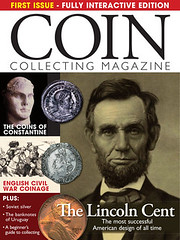 Contents of issue 1:
Contents of issue 1:
- News
- Auction results
- the Coins of Constantine
- The English Civil war
- The Lincoln cent
- Soviet silver examined
- Coins of the Roman Empire
- Collector Q&A
- Bar Kokhba revolt
- Edward I coins
- Italy’s Euro error
- Banknotes of Uruguay
- New Coin issues
- English shillings explained
- Canada’s controversial coin
- Henry III’s gold florin
To read the earlier E-Sylum article, see: ALL-DIGITAL COIN COLLECTING MAGAZINE DEBUTS (www.coinbooks.org/esylum_v16n18a04.html)
ARCHIVES INTERNATIONAL JUNE 4TH, 2013 AUCTION
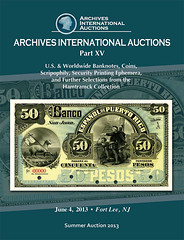 International Auctions and Dr. Robert Schwartz are proud to present,
International Auctions and Dr. Robert Schwartz are proud to present,
Rare U.S. & Worldwide Banknotes, Coins, Scripophily and Security Printing Ephemera
Including Additional Selections from the Hamtramck Collection; The Somerset Collection as well as distinguished Properties of Banknotes, Coins and Scripophily from various consignors.
June 4th, 2013 at our offices in Fort Lee, New Jersey
Included will be over 1,000 lots of Rare Worldwide Banknotes, Coins, Scripophily and security printing ephemera. Please view our website for auction updates
Highlights include dozens of amazing banknote, Scripophily & Coins:
- An outstanding group of high grade Encased U.S. Postage from a 200 year old estate
- Dozens of rare and desirable worldwide and U.S. banknotes that have been off the market for up to 40 years from the Hamtramck Collection
- Additional selections from American Banknote Commemoratives Inventory including many modern rarities never offered previously at auction
- Numerous Scripophily rarities from railroads to mining to internet and foreign material
- An original John “Law” signed letter from 1720
PLEASE CONTACT US IF YOU WOULD LIKE TO RECEIVE A CATALOG FOR THIS EXCEPTIONAL AUCTION OR ARE CONSIDERING CONSIGNING UPCOMING AUCTIONS.
You may also bid through our website at Archives International Live.
Archives International Auctions, LLC
1580 Lemoine Avenue, Suite #7
Fort Lee, NJ 07024
Phone: 201-944-4800
Email: info@archivesinternational.com
THE BOOK BAZARRE
STACK FAMILY INGOT DONATIONS TO THE NATIONAL NUMISMATIC COLLECTION
Last week Nick Graver suggested to me:
I contacted NNC Curator Dick Doty, who put me in touch with Collection manager Robyn Einhorn, who kindly forwarded the following list, image and disclaimer.
NOTE: THE SMITHSONIAN and its National Museum of American History has not VERIFIED THE AUTHENTICITY OF OBJECTS in question and makes no representations about their authenticity but does make the collection available to independent researchers.

National Numismatic Collection (NNC),
National Museum of American History,
Smithsonian Institution.
| Catalog Number | Material | Assayer | Year | Country |
| 86.0985.01 | mixed bar 5.03 gold/ 15.27 silver | Blake& Co. | ||
| 86.0985.02 | mixed bar 6.31 gold/ 16.52 silver | L. Kuh | ||
| 86.0985.03 | silver bar 15.0 | |||
| 86.0985.04 | silver ingot 8.10 | Bethune &Brooks | ||
| 86.0985.05 | silver bar 4.54 | Comstock Lode? | ||
| 86.0985.06 | silver ingot 4.21 | Thorne Mining Co. | ||
| 86.0985.07 | silver bar 5.48 | Eagle Mining Co. | ||
| 86.0985.08 | mixed bar 17.91 gold/28.62 silver | Hentsch & Berton | ||
| 86.0985.09 | gold bar 6.27 | Hentsch & Berton | ||
| 86.0985.10 | gold bar 39.92 | Bell | ||
| 1977.0419.01 | gold ½ ingot 156.41g | Mexico City Mint | 1741 | |
| 1977.0419.02 | gold rectangular tablet | Mexico City Mint | 1744 | Mexico |
| 1977.0419.03 | gold ingot 358.100g | Mexico City Mint | 1744 | Mexico |
| 1977.0419.04 | gold ingot 358.100g | Mexico City Mint | 1746 | Mexico |
| 1977.0419.05 | gold tablet 133.42g | Mexico City Mint | 1746 | Mexico |
| 1977.0419.06 | gold tablet 133.42g | Mexico City Mint | 1746 | Mexico |
| 1977.0419.07 | gold tablet 86.315g | Mexico City Mint | Mexico | |
| NU*80.24.1 | gold ingot 206.50 | Eagle Minning Company | ||
| NU*80.251.1 | gold bar 135.378g | Star Mining Company | ||
| NU*80.27.1 | oval gold bar 31.350g | The Far East | ||
| NU*80.27.2 | rectangular gold bar 31.081g | The Far East | ||
| NU*80.27.3 | oval silver bar 37.290g | The Far East | ||
| NU*80.28.1 | silver bar 104.008g | Thorne Mining and Refining Company | ||
| NU*80.28.2 | silver bar 6.39g | Eagle Mining Company | ||
| NU*80.28.3 | silver bar 6.84 | Nevada Silver Company | ca. 1955 | |
| NU*80.29.1 | gold bar 50.064g | Engelhard | ||
| NU*80.29.2 | gold bar 58.321g | Samuel Montagu & Company | England | |
| NU*77.83.01 | electrum ingot ½ stater (Milesian standard) | possibly 9th century BC | Ancient Greek/Asian Minor | |
| NU*78.74 | gold ingot 20.00 | Conrad Wiegard | 1867 | |
| NU*79.17.01 | silver bar | “Santa Casa de Misericord a” Department of gold in Sao Paulo, Brazil | 1932 | Brasil |
| NU*79.48.01 | silver bar 7.68 | San Francisco Assaying and Refining | 19th Century | |
| NU*79.92.01 | gold bar short truncated pyramid | 6-May-01 | ||
| NU*64479 | silver ingot 7.77 | Nevada Silver Company | 1876 | |
| NU*62082 | silver ingot 90.96 | Nowgorod | ca.1430 | Russia |
To read the earlier E-Sylum article, see: THE HARVEY STACK INGOT COLLECTION (www.coinbooks.org/esylum_v16n15a21.html)
MORE ON JOHN C. LIGHTHOUSE
Marc Ricard writes:
My great-great-grandfather was J.C. Lighthouse. A portion of his collection was auctioned many years ago, and a portion remains in private hands. Our family can verify the true scope of his massive collection.
Ken Berger notes:
In the John C. Lighthouse article, the date of the San Francisco earthquake should read 1906, not 1905.
In last week’s issue of The E-Sylum under “John C. Lighthouse” you asked the question, “Would any of our readers know the current whereabouts of Lighthouse-pedigreed coins?”
I can shed a little light on the location of some Lighthouse-pedigree coins, in particular six early silver dollars dated 1795-1801.
Milferd H. Bolender, dealer and author of The United States Early Silver Dollars from 1794 to 1803 (1950) sold his personal reference collection of silver dollars in his 183rd Sale, February 23, 1952. Bolender was very careful to note pedigrees for the majority of the early dollar Lots offered. And great pedigrees they had, including Stickney, Parmelee, Earle, Haseltine, Mougey, Newcomer, Col. Green, Jenks and many others. Lighthouse was another.
Bolender was likely a buyer in J. C. Morgenthau & Co.’s sale of the J. C. Lighthouse Collection, February 18-19, 1936. Bolender was actively forming his reference collection at this time. (If anyone has a copy of the 1930 Morgenthau & Co. Lighthouse Sale with buyer’s names please let me know at wdperki@attglobal.net). Regardless, Bolender has six early dollars in his personal collection that were listed as having come from the Lighthouse Collection. In Bolender’s February 1952 sale catalog I note six lots pedigreed to Lighthouse, as follows:
Lot 17. 1795 B-14 Draped Bust, Small Eagle Dollar (DB SE), Very nearly uncirculated. Both obverse and reverse of this coin are the plate photos in the Bolender book. This specimen was purchased by Kenneth P. Austin of Salisbury, MD in this sale. Bolender purchased the Austin early dollar collection privately and sold the collection including this specimen to the Ostheimers. This specimen was next offered at public auction as Lot 814 in Superior Stamp and Coin’s 1975 A.N.A. Sale, August 19-23, 1975. The obverse and reverse were plated in this sale catalog.
Lot 41. 1798 B-4 Draped Bust, Heraldic Eagle (DB HE) Knob Nine Dollar. Ex. fine. Reverse of this coin was plated in the Bolender book. This was purchased by W. G. Baldenhofer in this sale and was later sold privately by Baldenhofer to Bolender. Bolender sold the Baldenhofer early dollar collection to the Ostheimers, including this specimen. 1798 B-4 is a rare die marriage (R-5), and a decent specimen in Extremely Fine or higher grades is very difficult to locate.
Lot 53. 1798 B-11a, DB HE Dollar, Very fine. No plate photos for this specimen.
Lot 106. 1799 B-10b, DB HE Dollar. Fine. Like Lot 41 above, this specimen was purchased by W. G. Baldenhofer in this sale and was later sold privately by Baldenhofer to Bolender. Bolender sold the Baldenhofer early dollar collection to the Ostheimers, including this specimen. No plate photos for this specimen.
Lot 149. 1800 B-14a, DB HE Dollar. Very fine. Like Lots 41 & 106 above, this specimen was purchased by W. G. Baldenhofer in this sale and was later sold privately by Baldenhofer to Bolender. Bolender sold the Baldenhofer early dollar collection to the Ostheimers, including this specimen. No plate photos for this specimen.
Lot 165. 1801 B-2, DB HE Dollar. Extremely fine. No plate photos for this specimen.
In summary, at least a couple of the early dollar specimens can be traced in the future to the Lighthouse Collection by plate photos and public auction sale plate photos, with additional pedigree information available on some specimens. The original auction flip from the 1975 A.N.A. Sale: 814 was retained for the 1795 B-14 DB SE Dollar.
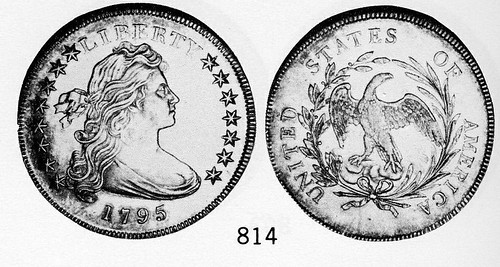
To read the earlier E-Sylum article, see: JOHN C. LIGHTHOUSE (www.coinbooks.org/esylum_v16n18a14.html)
NOTES FROM E-SYLUM READERS: MAY 12, 2013
The Drakkar Viking Ship on American Coinage
O. T. Thompson, who signs himself as "the LAST Viking in North Carolina!" writes:
Regarding your article in the May 5, 2013 E-Sylum on 'Ships on American Coinage', SHAME on Charles Morgan and Hubert Walker for delegating the great Viking ship to ONLY an 'Honorable Mention'!
The Drakkar was THE basis for ALL ships these authors thought were 'significant'! It pioneered the way for America's discovery nearly five-hundred years BEFORE Columbus and can NOT be ignored! SHAME!
Howard A Daniel III adds:
My source for information about ships/boats on coins is Yossi Dotan's two volumes, Watercraft on World Coins.
To read the earlier E-Sylum article, see: SHIPS ON AMERICAN COINAGE (www.coinbooks.org/esylum_v16n18a22.html)
To read the earlier E-Sylum articles on Yossi Dotan's books, see:
REVIEW: WATERCRAFT ON WORLD COINS, VOLUME I BY YOSSI DOTAN
(www.coinbooks.org/esylum_v10n45a05.html)
NEW BOOK: WATERCRAFT ON WORLD COINS, VOL. II: AMERICA AND ASIA, 1800-2008
(www.coinbooks.org/esylum_v13n22a06.html)
Dueling Porpoises
Last week I quoted the April 2013 PAN eNews:
PAN president Tom Uram will be making the trip to Schaumburg IL for the Central States Show. His trip is duel purposed. He is taking material to promote PAN and will also be entering an exhibit, Morse code on Money.
Leon Saryan writes:
Who is Uram going to shoot at?
Leon adds:
I hope he's not after me, as my exhibit in the same category placed higher than his!
To read the earlier E-Sylum article, see: MORSE CODE IN NUMISMATICS AND THE MAY 2013 PAN SHOW (www.coinbooks.org/esylum_v16n18a19.html)
Spink Titles Not New
Numismatic literature dealer Charlie Davis writes:
Those "new" Spink titles are from 2004!! I have had them in stock for 9 years.
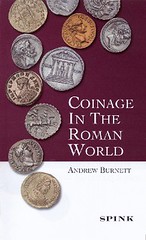
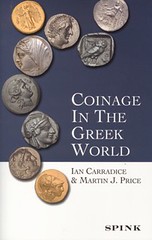
To read the earlier E-Sylum articles, see:
NEW BOOK: COINAGE IN THE ROMAN WORLD
(www.coinbooks.org/esylum_v16n18a02.html)
NEW BOOK: COINAGE IN THE GREEK WORLD
(www.coinbooks.org/esylum_v16n18a03.html)
More on eBay and Cuba Embargo
Alan V. Weinberg writes:
Simply splendid issue of The E-Sylum. I was riveted by the J.C. Lighthouse and Harvey Stack accounts.
Regarding Orlando Pina's letter to eBay on the Cuban numismatics embargo issue, I just learned from the PCGS Coin Forum that the US. Ambassador to the United Nations Human Rights Council is Eileen Chamberlain Donahoe, who is the wife of John Donahoe, CEO of eBay.
That sure puts a new light on this eBay policy embargoing all things Cuban numismatics and from where this silly all-compassing policy originates. "Using an axe to kill a fly on the forehead" indeed! Notwithstanding that, there are millions of people of Cuban descent in the U.S. and a U.S. Senator and how many Congress members?
To read the earlier E-Sylum article, see: MORE ON EBAY'S BAN OF CUBAN COINS AND BANKNOTES (www.coinbooks.org/esylum_v16n18a11.html)
Minting vs. Printing
Tom Sheehan writes:
Now with 3D printers has anyone copied a coin? How fast could someone print $1,000.00 in dollar coins? I understand that an operational gun has been made with a 3D printer.
Separating Damp Banknotes
Joe Boling writes:
I hope somebody told the owner of the Tennessee safe hoard that he does not need to dry out and try to separate his mass of damp notes. The BEP will do it for free, and likely salvage more value than the owner would be able to recover.
To read the earlier E-Sylum article, see: TENNESSEE FAMILY FINDS COINS AND SILVER IN HIDDEN SAFE (www.coinbooks.org/esylum_v16n18a26.html)
SCOVILL SUBJECT OF MUSEUM ORAL HISTORY PROJECT
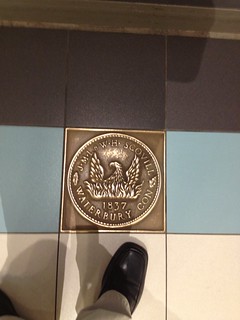 The motif of an 1837 medal by Scovill Manufacturing -- found in the floor
tiles of a shopping center built on the site of the old Scovill plant in
Waterbury Connecticut -- is the symbol of a project to preserve an oral
history by some former employees.
The motif of an 1837 medal by Scovill Manufacturing -- found in the floor
tiles of a shopping center built on the site of the old Scovill plant in
Waterbury Connecticut -- is the symbol of a project to preserve an oral
history by some former employees.
The Mattatuck Museum of Waterbury, in conjunction with the last remaining division of the old Scovill Manuacturing Company, now located in Clarksville, Georgia, are sponsoring a three-day project to record taped interviews of former employees, family members and anyone with special knowledge of Scovill.
On Wednesday, May 15, a panel of three experts on Scovill will talk on their eminences of the company. This program begins at 5:30 pm at the Mattatuck Museum, 144 Main Street Waterbury. E-Sylum readers in the area are welcome to attend. Admission is free.
Scovill is well known in the numismatic field for their production of virtually all of America's Hard Times and Jackson tokens, plus a large percentage of Civil War tokens. It produced blanks for minor coins for the U.S. Mint over a 40-year period until the Mint built a new plant in 1901. The firm also issued transportation tokens, sales tax tokens as it continued to make numismatic items into the 20 century.
The firm also supplied blanks for foreign government coins beginning in 1875 for Venezuela. This led the following year to to striking these coins intact. It minted 22 different coins for ten different countries. Collectors began calling Scovill the "Waterbury Mint" but there is no record the company used, or sanctioned, this term.
For 150 years Scovill dominated the brass industry, metalworking in New England and small metal products manufactured in America throughout its history. It is noted most for is manufacturing of metal buttons -- an early product of its founders right up to its demise for the most part in the 1980s -- and its military products during four American wars.
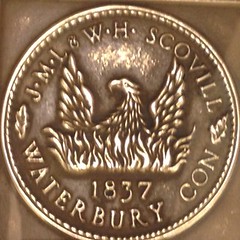 At its height it consumed a third of all the copper produced in America,
combining this with zinc to make brass. It produced so many products in this
metal it earned the name "Brass City" for Waterbury where its many plants
were located..
At its height it consumed a third of all the copper produced in America,
combining this with zinc to make brass. It produced so many products in this
metal it earned the name "Brass City" for Waterbury where its many plants
were located..
Scovill's most noted creation is the production of 23,757 Columbian Exposition Award Medals. The U.S. Mint was commissioned to make these medals but exposition officials wanted raised lettering for the recipient's name on the reverse.
After creating the dies the Mint learned it could not create the raised lettering. It commissioned Scovill, who solved the problem with insert dies, requiring a small staff of engravers, clerks and pressmen 18 months to strike the full number required.
Scovill also created its own Centennial Medal with the same raised lettering for recipients' names in 1902.
The Oral History project is being conducted under the direction of Cathy Sigmon, current Scovill Archivist. Dick Johnson was project manager.
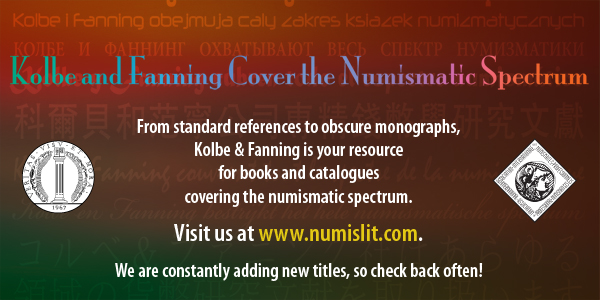
SOME ROOSTER COUNTERSTAMPS
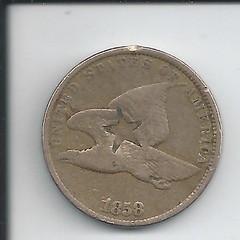
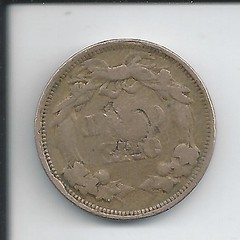
I was looking at a coin I have with a star on the obverse and a rooster on the reverse. The rooster is kind of weak, probably because the star was done after the rooster and it compromised the integrity of the fowl.
I knew I'd recently seen something about a rooster stamp, but I couldn't remember where. I did a search of The E-sylum archive and came up with three things: Gene Brandenburg's "chicken" coin from March 3 of this year, which has the same stamp as mine; a report that Frank Rooster was among six new subscribers in the April 26, 2009 issue. (He's a bird who tells it like it is.); and from the October 9, 2003 issue, a report that in Amesbury, Mass., a rooster was killed and inside his crop were found 13 nickel cents and 2 2-cent pieces. It was remarked that this was the first known instance in which the numismatic fever attacked a lower animal.
I combed through some of my books, but all I could find were references to a rooster stamp in Russell Rulau's book and in Gregory Brunk's book. The consensus is that the stamp was done in Massachusetts, but why and by whom are unknown.
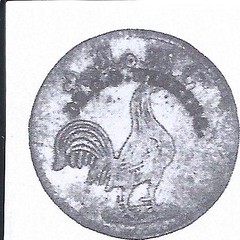 The rooster from Lewiston, Maine is a different stamp. The rooster on the Sumatran 4-Keping coin (with the G.G.Wilkins counterstamp) is not a stamp; it's part of the coin, but since we're discussing coins and roosters I thought I'd throw that in.
All these words and all I've really said is that the stamp looks to be from Massachusetts.
The rooster from Lewiston, Maine is a different stamp. The rooster on the Sumatran 4-Keping coin (with the G.G.Wilkins counterstamp) is not a stamp; it's part of the coin, but since we're discussing coins and roosters I thought I'd throw that in.
All these words and all I've really said is that the stamp looks to be from Massachusetts.
To read the earlier E-Sylum article, see: QUERY: CHICKEN COUNTERSTAMPS (www.coinbooks.org/esylum_v16n09a14.html)
THE PLACE OF FAKES IN NUMISMATICS
Would you believe that everything numismatic has a value to someone – even counterfeit and altered coins. I don’t recall this always being the case.
In the 1970s, altered coins had no collector value and counterfeits like the one above were only worth the intrinsic value of their unknown fineness of gold. Once a coin was determined to be a counterfeit, it was returned to the submitter with a note that the coin should be turned over to the Secret Service so they could trace it back to its source of manufacture. Many dealers simply kept an assortment of their “bad” purchases in a reference collection or defaced/melted them to remove them from the marketplace.
My first purchase of a fake coin for the teaching set I would form for my counterfeit seminars was a “so-called” Racketeer nickel. These were the first type of 1883 Liberty nickels without “Cents” on the reverse that were gold plated and then passed as $5 coins to the unwary. It was years later when I purchased another of these gold plated coins with a reeded edge that I learned that my first purchase (with the smooth edge of a common nickel) was actually just an altered coin – a fake of a fake.
Formerly, when coins that were considered to be genuine were discovered to be fakes, they were dropped from the reference books. Several Colonial specimens and some Territorial material have met this fate. Times have changed. Today, many counterfeits are no longer “worthless weeds” in a collection. There is even a reference book: “Contemporary Counterfeit Capped Bust Half Dollars” by Keith Davigon that I should like to own one day. It catalogs the known contemporary fakes in this popular series. Today these coins and others such as the counterfeit British coins made at Machin’s Mills can sell for hundreds of dollars. Other counterfeits such as the Micro “O” Morgan dollar coins are still listed with the notation that they are “privately made.” They are very collectible and bring good prices. If this trend continues, we may find other “privately made” coins such as the crude, counterfeit, magnetic, Peace dollars coming from China listed, valued and avidly collected in decades to come.
I’m not suggesting that you buck this trend. You may wish to start a collection of fakes for your own use. Otherwise, if someone wishes to purchase your counterfeit or altered coins, sell them for what they are. Ever since eBay closed down the Counterfeit/Replica section, it has become much harder to find coins for my teaching set. Ebay was also a good way to track improvements to the quality of modern fakes being offered.
To read the complete article, see: Fakes Finding Place in Numismatics (www.numismaster.com/ta/numis/Article.jsp?ad=article&ArticleId=26841&et_mid=617213&rid=2226673)
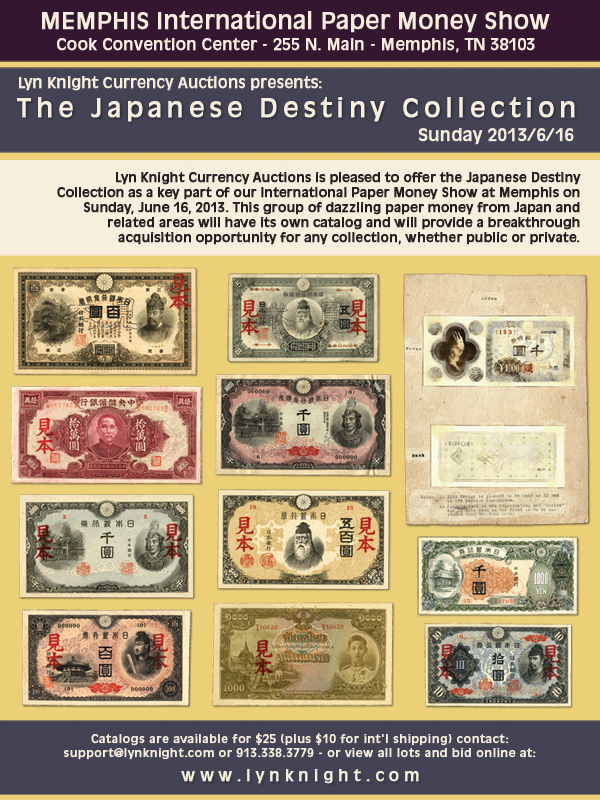
HARVEY STACK ON THE DAVIS-GRAVES COLLECTION, PART III
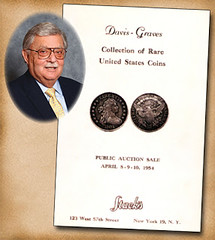 At this point I had to consider, “How does one pack such a collection?” But I had learned from my father and uncle on earlier trips. Conveniently the caretaker provided me with special large sheets of tissue that had been used to wrap the special needles the factory once produced. The needles had needed protection from damage of any kind, as perfection was necessary, and so the tissue was perfect for my use. To pack the coins I took one tray at a time to the large conference table, laid out a sheet of this fine tissue, put about eight to ten coins end to end, and then folded the tissue over the top. Then I placed another row, folded it over again, and so on until I had six or seven layers. I then folded the ends over, tightened the tissue about the package and used a special tape they still had in the factory to keep it closed. I then set the flat package aside on the table. I did this over and over, 90 to 100 times. I had to be very careful and make the packages tight so the coins would not touch each other in any way, even after I packed them in special jeweler’s cases and put them in the car for the return trip to New York.
At this point I had to consider, “How does one pack such a collection?” But I had learned from my father and uncle on earlier trips. Conveniently the caretaker provided me with special large sheets of tissue that had been used to wrap the special needles the factory once produced. The needles had needed protection from damage of any kind, as perfection was necessary, and so the tissue was perfect for my use. To pack the coins I took one tray at a time to the large conference table, laid out a sheet of this fine tissue, put about eight to ten coins end to end, and then folded the tissue over the top. Then I placed another row, folded it over again, and so on until I had six or seven layers. I then folded the ends over, tightened the tissue about the package and used a special tape they still had in the factory to keep it closed. I then set the flat package aside on the table. I did this over and over, 90 to 100 times. I had to be very careful and make the packages tight so the coins would not touch each other in any way, even after I packed them in special jeweler’s cases and put them in the car for the return trip to New York.
I started at 8:00 in the morning and continued packing until about 3:00 in the afternoon, always checking the inventory, with just some coffee and cake brought to me mid-day by the caretaker. I was pretty sure neither my father or uncle could have done this without help, but I was on my own and had to complete the job. As I finished the packing, the lawyer for the owner came in and asked me if everything had checked out okay. When I reported that it had, he gave me a check, bid me goodbye and left me and the caretaker to take the cases to the car and load them up before I started my long drive back to New York.
I called ahead to let my father know I was on my way and that it would be about 10:00 at night before I would be back to the office. He gave me the customary fatherly advice to drive carefully and that he would be waiting for me when I got there. As I drove home I thought about all the coins I had packed and how they had been in that cabinet a number of years, unattended, and were still of the same quality and beauty as when they were placed there decades earlier. I still wonder at how it stayed so safe for so long in that office.
The Davis-Graves Collection was the first major collection I picked up alone and being given such a responsibility was a compliment from my family. To this day I remember the experience and how I had been taught to conduct myself when dealing with a collectors and the valuable numismatic properties that eventually go on to others who will also appreciate the wonders of collecting. It is our obligation as coin dealers to provide the vehicle by which items in one collection move to another, so that the beauty and joy of collecting can be perpetuated from one generation to another. That is the way collections are built and how the appreciation of numismatics grows. A dealer can share the enthusiasm of what has been done before and encourage it to be done again in the future.
To read the complete article, see: Remember When: Bringing Home A Coin Collection In 1953 (stacksbowers.com/Blogs/remember-when-bringing-home-coin_9.html)
To read the earlier E-Sylum article, see: HARVEY STACK ON BRINGING HOME THE DAVIS-GRAVES COLLECTION (www.coinbooks.org/esylum_v16n18a21.html)
MAGICAL NUMISMATICS: THE SILVER SHILLING
The fairy tale is called “The Silver Shilling” and begins as follows: “There was once a shilling, which came forth from the mint springing and shouting, ‘Hurrah! Now I am going out into the wide world.’ And truly it did go out into the wide world. The children held it with warm hands, the miser with a cold and convulsive grasp, and the old people turned it about, goodness knows how many times, while the young people soon allowed it to roll away from them.”
The fairy tale, however, isn’t just concerned with such elementary wisdom, but the author deals with the intrinsic value of the piece of money as well: “The shilling was made of silver, it contained very little copper …”

Denmark. Pattern of 1 skilling 1809
At the time Hans Christian Andersen wrote his fairy tales, however, that was already obsolete. The Napoleonic Wars had made the Danish treasury almost go bankrupt. Until 1908, in Denmark, too, shillings – or skillings, respectively – weren’t made of silver anymore but of copper.
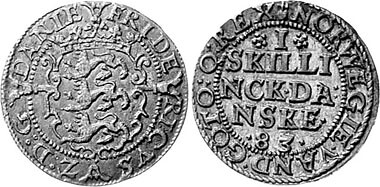
Denmark. 1 Skilling 1583
Thus, our old shilling Hans Christian Andersen refers to was a particularly good piece of money, a valuable one, of appropriate weight and fineness – unlike its successor, a coin without intrinsic value. But how dealt the 19th century with unknown coins? Roughly 100 before, it had been normal procedure that anyone could bring foreign currency to a mint that took it at material value at a small extra charge. In the 19th century, however, the production of coins had been centralized with only some major cities still having its own mint.
In addition, states in all of Europe had begun to accept only their own currency or the currency of the countries they had formed a monetary union with, respectively. Consequently, he who intended to visit another country was forced to travel with local currency since his own, local money wasn’t accepted anywhere else. That made the number of different types of money circulating decline considerably – as a result, our shilling, which its owner had taken with him to another country only to get lost there – faced the frightening experience that no one in the entire country wanted to possess it. “That is not a genuine coin of the country,- it is false; it is good for nothing.” Such were the remarks our coin had to listen to from then on.
To read the complete article, see: Magical Numismatics: The Silver Shilling (www.coinsweekly.com/en/Magical-Numismatics-The-Silver-Shilling/8?&id=292&type=a)
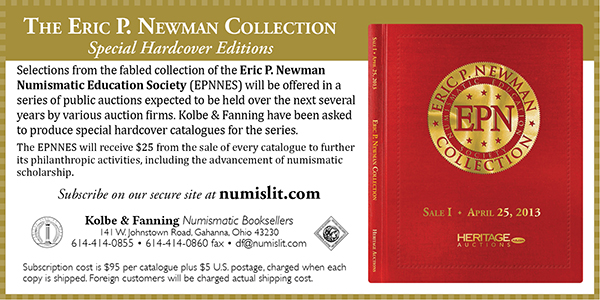
MOVIE REVIEW: WHO’S MINDING THE MINT?
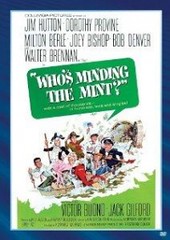 Who's Minding the Mint? is the kind of comedy they don't make anymore: all-star and mad, mad, mad, madcap. It was released in 1967, which is the year that such old-Hollywood projects were put out to pasture by such edgy fare as The Graduate and Bonnie and Clyde. I'd argue Mint — while pure, cotton-candy fluff compared to those prestige pictures — has aged every bit as well.
Who's Minding the Mint? is the kind of comedy they don't make anymore: all-star and mad, mad, mad, madcap. It was released in 1967, which is the year that such old-Hollywood projects were put out to pasture by such edgy fare as The Graduate and Bonnie and Clyde. I'd argue Mint — while pure, cotton-candy fluff compared to those prestige pictures — has aged every bit as well.
Jim Hutton (TV's Ellery Queen) is one huge reason. An unheralded Everyman of comedy (because he died too young to get the respect he deserves), he plays Harry Lucas, a U.S. Mint inspector whose boss suspects he's on the take. He's not, but when he accidentally takes home $50,000 in a bag of fudge that he shreds in a sink disposal (just go with it), he faces not only losing his job, but his freedom.
Desperate and fearful of prison, Harry devises sort of a heist in reverse: If he can infiltrate the mint through a sewer one night, just to run the presses for the minute he needs, he can put the money back. It's not stealing; it's replacing — or so he reasons to recruit the aid of his old press pal Pop (Walter Brennan, Rio Bravo).
Pop agrees, but the plan becomes so complicated, it soon requires the aid of a semi-deaf safecracker (Jack Gilford), a pawn shop owner (Milton Berle), a sewer expert (Joey Bishop), a boat builder (Victor Buono), an ice cream vendor (Bob Denver) and a money cutter (Dorothy Provine). The latter doubles as a romantic interest.
When Harry learns the presses are to be replaced with automated ones, they must to enact their plan immediately, before they're ready. This allows director Howard Morris to force his characters to pull the caper while wearing a Scouts uniform, a ballet tutu, George Washington garb, etc. (Again, just go with it.) Pop even brings his pregnant dog.
Most of its jokes come from how Harry and the gang react to and/or cope with what goes wrong, which is everything. Comedies of this era are often charming and pleasant to sit through; this one actually made me laugh out loud more than once.
It's rife with slapstick, but it's smart. It's preposterous, yet wholly ingratiating. It's far from subtle, but it's an absolute joy.
To read the complete article, see: Who’s Minding the Mint? (www.okgazette.com/oklahoma/article-18220-who%E2%80%99s-mindin.html)
To read an earlier E-Sylum article, see: BOB DENVER AND THE "MINT" (www.coinbooks.org/esylum_v08n39a28.html)
LOOPY LEW'S PENMANSHIP PROGRESS
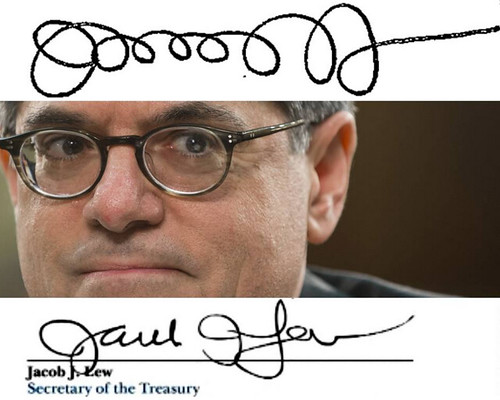
When US President Barack Obama nominated Jack Lew as the new Secretary of the US Treasury in January, the media had one overwhelming concern about the appointment: Lew’s illegible signature, which resembles the doodle of an absent-minded child, would now appear on every US banknote.
“I had never noticed Jack’s signature,” Obama joked as he announced Lew’s elevation. “And when this was highlighted in the press, I considered rescinding my offer to appoint him.”
Now Lew has made good on his promise. Though the banknotes featuring his signature have yet to enter circulation, reporters spotted an improved version of the former scrawl in a new report published by the Financial Stability Oversight Council. Lew’s first name, middle initial and last name are all now semi-legible in the updated autograph.
However, administration officials have warned that the new Secretary’s signature on forthcoming dollar bills remains a work in progress, and that the new currency will feature a third and final iteration of Lew’s loopy scribble.
Though this is an extreme case, it is not uncommon for Treasury Secretaries to hone their John Hancocks before adding them to banknotes. Former Obama Treasury Secretary Timothy Geithner said in an interview last year that he, too, had been asked to improve his signature after submitting it to the Bureau of Printing and Engraving.
To read the complete article, see: Treasury boss who drove President Obama loopy hits on a new signature for bank notes (/www.independent.co.uk/news/business/news/treasury-boss-who-drove-president-obama-loopy-hits-on-a-new-signature-for-bank-notes-8606812.html)
To read the BBC News article, see: US Treasury Secretary makes loopy signature clearer (www.bbc.co.uk/news/business-22449532)
Dennis Tucker adds:
This makes me think of Betty Edwards’s classic book, Drawing on the Right Side of the Brain. She has a section on handwriting and signatures, and guidance on how anyone can consciously change their sloppy/lazy signature into something more reflective and thought-out. It’s something that every artist (I immediately think of cartoonists, since that’s my “thing”) will think about sooner or later. “How should I sign my name?” It’s interesting to observe the latitude designers have had in numismatics, where they’re working with a tiny tondo and an even smaller space for their initials. Adolph Weinman’s elegant identification on the Liberty Walking half dollar comes to mind --- a lot different from the plain block lettering we see on modern commemoratives and circulating coins.
MORSE CODE ON MONEY
Numerous coins over the years have featured Morse Code, most notably from the US, Canada and Great Britain. And not surprisingly, given its strategic importance in military conflict, Morse code is often seen on war coin commemoratives.
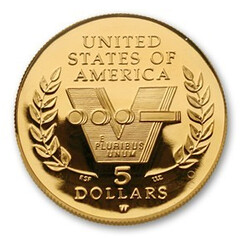 The United States World War II 50th Anniversary commemorative gold $5 dollar dated 1991-1995 and struck at the West Point mint, features “dot-dot-dot-dash” super-imposed over a capital “V”. The “V”, a signal often used by the indomitable Winston Churchill during World War II, became a symbol of hope to the beleaguered nations fighting the Nazi regime. The Morse Code, spelling the letter V, reinforces the symbolism. Many older Americans well remember newsreel footage of the portly figure, hand raised in the gesture, that was flashed over thousands of movie screens. Even today, it reminds us of his oft-quoted maxim to “never, never, never quit.”
The United States World War II 50th Anniversary commemorative gold $5 dollar dated 1991-1995 and struck at the West Point mint, features “dot-dot-dot-dash” super-imposed over a capital “V”. The “V”, a signal often used by the indomitable Winston Churchill during World War II, became a symbol of hope to the beleaguered nations fighting the Nazi regime. The Morse Code, spelling the letter V, reinforces the symbolism. Many older Americans well remember newsreel footage of the portly figure, hand raised in the gesture, that was flashed over thousands of movie screens. Even today, it reminds us of his oft-quoted maxim to “never, never, never quit.”
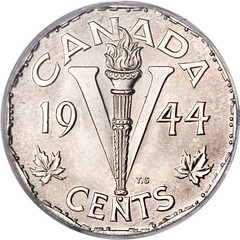 Canadian Victory Nickel (1943-1945), celebrating the success of the Allied Powers in World War II, was designed by Thomas Shingles. The phrase “We win when we work willingly” is engraved around the edge of the coin in Morse Code. In 2005, a commemorative of the “V” nickel was issued with the dates 1945-2005 to mark the 60th anniversary of V-E Day.
Canadian Victory Nickel (1943-1945), celebrating the success of the Allied Powers in World War II, was designed by Thomas Shingles. The phrase “We win when we work willingly” is engraved around the edge of the coin in Morse Code. In 2005, a commemorative of the “V” nickel was issued with the dates 1945-2005 to mark the 60th anniversary of V-E Day.
The issue's theme is "Build & Exhibit". The featured articles are written by people who've built exhibits on their topic, and each has a sidebar with the author's comments on the exhibiting experience.
It's not too early for bibliophiles to start planning to exhibit at the ANA's World's Fair of Money convention in Chicago in August. NBS raised donations totaling $3,000 to fund the numismatic literature exhibit class (Class 17 - Aaron Feldman Award). Let's have a wealth of exhibits on display! The application deadline is June 21, 2013. For more information, see: http://worldsfairofmoney.com/collector-exhibits.aspx . -Editor
To read the earlier E-Sylum article, see: MORSE CODE IN NUMISMATICS AND THE MAY 2013 PAN SHOW (www.coinbooks.org/esylum_v16n18a19.html)
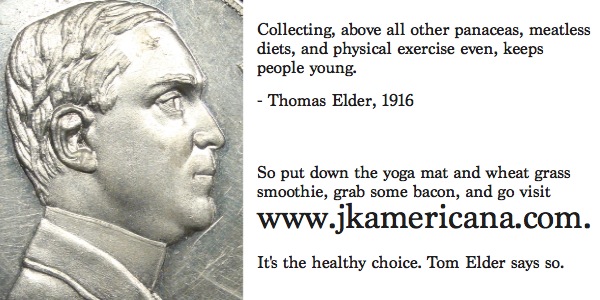
KEN POTTER ON DIES AND MINTING
 I read with interest the series on Watch Fobs by Dick Johnson and Bill Hyder (independent of one another). I ran into this image on my hard drive. It is a hub with an Integral loop from out of the now defunct Roger Williams Mint. Not for a Watch Fob but interesting nonetheless. I have many hubs from the hoard that was sold off after the Mint closed. Many have the loops described in this series which for some reason are now of far greater interest to me than they were before I read this series.
I read with interest the series on Watch Fobs by Dick Johnson and Bill Hyder (independent of one another). I ran into this image on my hard drive. It is a hub with an Integral loop from out of the now defunct Roger Williams Mint. Not for a Watch Fob but interesting nonetheless. I have many hubs from the hoard that was sold off after the Mint closed. Many have the loops described in this series which for some reason are now of far greater interest to me than they were before I read this series.
One day I'll have catalog all the ones I have just so folks know who made them. What I learned from the purchase of part of this hoard was that a lot of "paper mints" had their silver bars, medals, etc., manufactured there and then sold them off under their own names that incorporated the word Mint even though many of the sellers never even walked through a Mint.
I have a cracked Columbus die that might be the one mentioned in the current issue of E-Sylum v16#18 May 5, 2013. It cracked in several places and ended up with Brian Timmins who used to cut dies for me. He was contracted to make a new one in short order. At some later date he sold me a nice batch of broken dies for educational purposes which included this one. Not sure where it is (I have thousands of dies) but it is not far off. It was for a 5 oz round that mimicked the Columbian Half dollar. It looks like it did not last long.
I really enjoyed the article on Heat Treat. I found the account very interesting about the work hardening of coins and medals. I've had dies made that a now defunct Mint could not strike up fully to bring out the deep cameo effect. With other dies they could not even bring up the entire design. Once they hit the medallion two or three times, it was over. They told me they could hit it five more times and the design would not come up. This was due to work hardening.
I moved them to another Mint that had presses with what I presumed to have more "guts" and they were able to bring out a deep cameo without in anyway refreshing the dies. Other dies produced a superior, fully struck product that the other Mint was not able produce.
Later I learned that the defunct Mint's presses may have had the guts but that the press operator was afraid to turn up the pressure in fear of breaking my dies. A few years later he went to work for the new Mint and my problems began anew: light cameos, weak strikes, etc.
Once he revealed to me his concerns about turning up the pressure I told him to stop worrying about breaking dies and start making good products so that I wouldn't have to return them. I told him I had hubs to make new dies and would rather break dies every ten thousand strikes (or whatever) than to produce inferior products. Now I get a good product. All the problems had to do with work hardening setting in after two or three weaker than necessary strikes that prevented any further movement of metal into the dies.
The Liberty dollar story was interesting. The Mint that made the original strikes makes most of my products but I doubt they'd touch the Liberty dollars now.
Ken adds:
I just learned that Brian Timmins is still alive and well. He closed his company, Landmark Die Engraving, about two years ago but I was finally able to find him with a lot of searching last night after I found his son's company listed on Google and gave the son a call. Turned out his dad (Brian) walked in his son's house just as we were on the phone. Funny how this message to you led to me finding an old friend. Thanks!
To read the earlier E-Sylum articles, see:
ARE WATCHFOBS NUMISMATIC?
(www.coinbooks.org/esylum_v16n14a17.html)
WATCH FOBS AS NUMISMATIC ITEMS
(www.coinbooks.org/esylum_v16n15a15.html)
CORE COINING TECHNOLOGY: DIE HEAT TREATING
(www.coinbooks.org/esylum_v16n18a16.html)
NEW LIBERTY DOLLARS MADE WITH COPYRIGHT PERMISSION
(www.coinbooks.org/esylum_v16n18a12.html)
BUDGET CUTS IMPACT LIBRARY OF CONGRESS
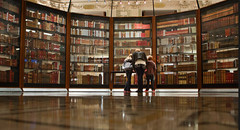 Just as military contractors, air traffic controllers and federal workers are coping with the grim results of a partisan impasse over the federal deficit, the Library of Congress, whose services range from copyrighting written works — whether famous novels or poems scribbled on napkins — to the collection, preservation and digitalization of millions of books, photographs, maps and other materials, faces deep cuts that threaten its historic mission.
Just as military contractors, air traffic controllers and federal workers are coping with the grim results of a partisan impasse over the federal deficit, the Library of Congress, whose services range from copyrighting written works — whether famous novels or poems scribbled on napkins — to the collection, preservation and digitalization of millions of books, photographs, maps and other materials, faces deep cuts that threaten its historic mission.
Of the $85 billion in federal cuts for the current fiscal year, known as sequestration, half will come from military spending, and half from domestic programs like health care, research, education and the library. The library’s budget for the year has declined to $598.4 million, a 4 percent cut that is likely to slow its digitalization effort and has already caused copyright applications to back up. The worry spreads far beyond Washington because the Library of Congress — founded in 1800, burned and pillaged by the British in 1814 and replaced by Thomas Jefferson’s personal library — is home to an unrivaled history of the nation’s wars, presidencies, culture and place in the world.
A tour of the library’s vast operations, spread across three large buildings in a sprawling Capitol Hill complex, reveals the enormity of its mission to preserve manuscripts for the future and to get at least some of them online.
On a recent morning, a pair of workers toiling in a room that seemed more like a pharmaceutical lab than like a library were carefully sifting through the library’s collection of historical meeting notes and other manuscripts from the N.A.A.C.P.
 The papers, like roughly 250,000 books and one million manuscript sheets each year, were undergoing a process that removes the acid that causes them to discolor and disintegrate. Because of the looming cuts, the deacidification process, ideally carried out before older books and documents are stored, could be reduced by 40 percent over the next five years.
The papers, like roughly 250,000 books and one million manuscript sheets each year, were undergoing a process that removes the acid that causes them to discolor and disintegrate. Because of the looming cuts, the deacidification process, ideally carried out before older books and documents are stored, could be reduced by 40 percent over the next five years.
“What all these things have in common is that they are going to decay,” said Mark Sweeney, the library’s director for preservation.
During the 2012 fiscal year, which ended Sept. 30, nearly six million items from the library’s collections were bound, repaired, mass-deacidified, microfilmed or reformatted for restoration. Most of these programs will experience cuts in coming months.
To read the complete article, see: As Works Flood In, Nation’s Library Treads Water (www.nytimes.com/2013/05/04/books/budget-cuts-hobble-library-of-congress.html)
THE DIAMOND SUTRA
Tom Fort writes:
 I just saw this on Wikipedia, while not directly related to numismatic books and/or literature today, the is the 1145th anniversary of the earliest surviving dated printed book: a copy of the Diamond Sutra that was printed in China on 10 May 868.
I just saw this on Wikipedia, while not directly related to numismatic books and/or literature today, the is the 1145th anniversary of the earliest surviving dated printed book: a copy of the Diamond Sutra that was printed in China on 10 May 868.
Sadly, the article does not state where the work is presently located, though from a reference in the text I suspect it resides in the British Library. Why not? They have everything else.
To read the complete article, see: en.wikipedia.org/wiki/Diamond_Sutra
THE BOOK BAZARRE
MORE ON THE SEDE VACANTE COINS

The Vatican already issued four stamps to commemorate this transitional period between the end of Benedict XVI's pontificate and the next Pope.
The value of the stamp is 70 cents in Italy, 85 for Europe, 2 euros for the Americas, and 2.50 euros for Australia. However their use was limited to the Sede Vacante period. When the new Pope is chosen, they will become collection pieces.
In addition to the stamps, a commemorative 2 euro coin will be minted for the Sede Vacante. It will go into circulation starting in June.
There will also gold and silver coins with a value of 5 and 10 euros, but will be strictly commemorative.
To read the complete article (and see a video), see: Vatican issues four stamps and three coins during Sede Vacante (www.romereports.com/palio/vatican-issues-four-stamps-and-three-coins-during-sede-vacante-english-9391.html#.UY0kebWNqXh)
To read the complete article, see: VATICAN RELEASES PLANS FOR 2013 SEDE VACANTE COINS (www.coinbooks.org/esylum_v16n09a24.html)
ROBOTS IN NUMISMATICS
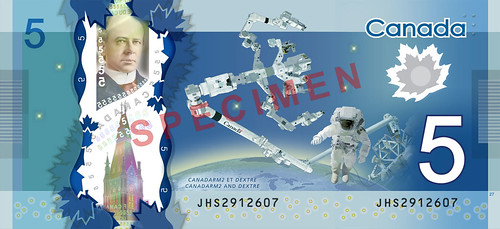
Banknotes often bear portraits of celebrated citizens – but normally they're human. In a giant leap for robotkind, Dextre and Canadarm2, two Canadian-made robots tasked with maintaining the International Space Station, will appear on the new Canadian $5 note, due to enter circulation in November.
From Charles Darwin, who features on the British £10 note, to Abraham Lincoln, who graces the US $5 bill, having your image on a banknote is one of the highest honours a nation can give. The robot arms earned the accolade by being Canada's most famous space travellers until Twitternaut Chris Hadfield.
The 17-metre-long, 1600-kilogram Canadarm2 helped assemble the ISS after it was launched in April 2001. Moving around the station autonomously, it now assists with upkeep and spacewalks, and helps to capture and dock unpiloted craft.
Dextre, meanwhile, arrived in 2008. With two 3.3-metre-long arms on its body, it repairs electronics and other features of the space station, freeing up the human astronauts to do other tasks.
Like the human banknote heroes before it, Dextre is also a pioneer, allowing experiments that could lead to the routine repair of satellites by robots.
As robot fans, we plan on paying for everything with Canadian $5 bills from now on. But it won't be long before a robot earns similar human admiration for its cognitive and social contributions, in addition to mechanical ones. We're looking forward to the first banknote starring a robot prime minister.
To read the complete article, see: Robot glory as Canada puts space arm on banknote (www.newscientist.com/article/dn23508-robot-glory-as-canada-puts-space-arm-on-banknote.html)
THE ROYAL AUSTRALIAN MINT'S NEW TRIANGULAR COIN
 Australia has minted its first triangular coin to mark the 25th anniversary of the opening of Parliament House.
Australia has minted its first triangular coin to mark the 25th anniversary of the opening of Parliament House.
The silver $5 coin, which costs $85 (£56), is 99.9 per cent silver. Only 10,000 coins have been minted for the celebrations.
Its reverse sports a design of the Canberra building's triangular flag mast, as seen from its courtyard.
'It is fitting that the mint is demonstrating its own innovation within a minting context with Australia's first triangular coin.'
To read the complete article, see: Coin with corners goes into circulation in Australia... and it's worth $80 more than its $5 face value (www.dailymail.co.uk/news/article-2321995/Coin-corners-goes-circulation-Australia--worth-80-5-face-value.html)

ORANIA: SOUTH AFRICAN ENCLAVE HAS LOCAL CURRENCY
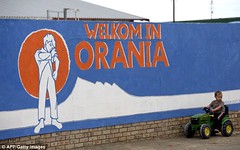 'Welkom in Orania' proclaims a mural, painted in white, blue and orange.
'Welkom in Orania' proclaims a mural, painted in white, blue and orange.
But this South African town, in the remote Northern Cape province, does not extend its welcome to everyone.
The colour scheme on the wall - accompanied by the community emblem of a boy pulling up his sleeves - harks back to the old apartheid flag.
Orania, one of the last outposts of racial segregation, is a whites-only enclave. Around 1,000 people live in the rural community, established in 1991 during the last years of apartheid.
Built on 8,000 hectares of private farmland along the Orange River in the desolate region of Karoo, it has schools, a museum and even its own currency, the Ora. All the residents are Afrikaners - descendants of white migrants of Dutch and German heritage - who make up about 7 per cent of South Africa's population.

A cashier holds Orania's currency
To read the complete article, see: Welcome to Orania... as long as you're white: Remote town in South Africa where Afrikaners dream of building their own state (www.dailymail.co.uk/news/article-2321236/Orania-Whites-town-South-Africa-Afrikaners-dream-building-state.html)
BOB EVANS ON THE LATEST S.S. CENTRAL AMERICA ARTICLE

The U.S. Marshals Service began using alerts on digital billboards in Ohio and Florida late last month to locate fugitive treasure hunter Tommy Thompson, who remains wanted after failing to appear in an Ohio court last year.
“They’ve generated some tips, but obviously not as many as we’d like to see,” Brad Fleming, a deputy U.S. marshal in Columbus, told FoxNews.com of the 10 billboards. “We haven’t received the right tip yet, so to speak.”
The billboard notices also include an image of Thompson’s assistant, Alison Antekeier, 45, whose arrest was ordered by U.S. District Judge Edmund Sargus Jr. in August along with Thompson after they failed to appear in court in Columbus.
To read the complete article, see: Feds go digital in hunt for fugitive 'Ship of Gold' treasure hunter (www.foxnews.com/us/2013/05/07/feds-use-digital-billboards-in-hunt-for-fugitive-treasure-hunter-who-found-ship/)
Since our editor was nice enough to give me a chance to analyze this article before it appeared in The E-Sylum, I will avail myself of that opportunity.
Mr. Joshua Rhett Miller writes for FoxNews.com. His work is a splendid illustration of the observation I made about news journalists in my previous essay in E-Sylum, where I counseled readers, “I would like to remind readers of the popular press that journalists are motivated to write interesting prose. They also write with deadlines and word counts in mind, and news writers tend to not be completely comprehensive and accurate in their reportage. They are not required to cite references or footnote their text.”
Frankly, my need to de-bunk articles like Mr. Miller’s most recent is a little perturbing, but I feel if I don’t do that here in E-Sylum, an important group of fellow numismatists might allow some of this nonsense to settle on their brains.
My goal is not to excuse Tommy Thompson entirely for all he has done or not done. Federal Judge Edmund Sargus Jr. has found him in contempt for not appearing in US District Court to testify in the case being heard there. It is that non-appearance that has now placed him on these “wanted-poster” billboards along with violent criminals, including at one point, the Boston Marathon bomber.
I could go point by point through Miller’s entire article, but that seems unnecessary. I can illustrate my argument by addressing three sentences that are rife with error and mischaracterization.
Let us take his opening sentence, which news editors will tell you is the most important part of an article. “The search for a treasure hunter who found sunken gold and then stiffed his partners by vanishing with the loot could be coming to a highway near you.” The real story is a lot more nuanced and complicated than that, and this opening is just plain misleading. It is colorful, so it accomplishes that particular journalistic goal.
First of all, Miller’s declaration omits his previous qualification of this statement (from his August 27, 2013 article,) “according to a lawsuit,” and in doing so elevates it, seeming now like a legal finding rather than an allegation. As well, it sounds as if Thompson vanished with some or all of the recovered sunken treasure, which is simply not the case. He may have taken possession of 500 commemorative coins that were produced from gold derived from Kellogg & Humbert ingots found with the treasure. (See my previous essay for a full explanation.) But even whether he took these coins, or if he actually deserved to receive them in lieu of many years of deferred salary is a point of legal contention, and nowhere to be found in Mr. Miller’s words.
Later in the article we find another paragraph that is false on many points:
“Exactly how much gold (was) recovered from the sunken ship’s gold remains unclear, although investors who ponied up for Thompson’s search claim they are due millions. His team of nine technicians is seeking more than $2 million and have been fighting for their cut in court for years.”
The amount of gold recovered from the shipwreck is completely clear. As I explained in my previous essay, I voluntarily served as an expert witness in court last autumn, having been requested to do so by the attorney for Thomson’s company. I did this largely to clear up the matter of the treasure inventory and tracking of the gold, and to dispel the depiction of our operations as loose and disorganized. My testimony made it absolutely clear that each piece of treasure was tracked from the time it was recovered from the sea-bed until it was delivered to the marketers.
Interesting, and perhaps all too “conveniently” so, is the fact that no news reporters were present at any time during my three days on the witness stand. It should be remembered that the principal plaintiff in the lawsuit in state court involving Thompson’s company is none other than The Dispatch Printing Company, the most powerful and influential news organization in central Ohio, the home turf of the project. Also, The Columbus Dispatch newspaper is the primary source for most if not all of the coverage of the two trials, federal and state. Mr. Miller’s words about confusion over the amount of gold are borrowed from his own FoxNews.com article of last August 27, “How much of the Central America's gold was recovered is unclear…” which was published, of course, before my appearance on the witness stand. Note that Miller now writes that this remains unclear, in spite of the passage of almost nine months and the production of plenty of evidence to the contrary. Apparently he thinks his own authority as an on-line news reporter about this matter is more persuasive than my sworn testimony, that of the Chief Scientist, Historian and Curator of the treasure.
My next point comes from the very next sentence: “His (Thompson’s) team of nine technicians is seeking more than $2 million and have been fighting for their cut in court for years.” This makes it seem as if Thompson had only nine technicians, and they all are suing. The company had dozens of technicians and engineers, and those who are suing are mostly the sonar team (and not even the entire sonar team) from the earliest at-sea phases of the project. The sonar anomaly that eventually proved to be the S.S. Central America was called a “large geological object,” not even a shipwreck, essentially a pile of rocks, by these folks. And now this bunch feels they are owed millions.
I could go on, but I won’t. The article is full of this kind of stuff.
Let the reader beware!
The truth about the treasure, both that which has been recovered and that which remains a mystery on the seafloor, is much more fascinating than this journalism, which meanders between a modicum of fact and a wealth of fiction and conjecture.
Your comments are welcome, either on this forum or privately at my email address: evans1857@gmail.com.
Bob Evans
Chief Scientist and Historian for the S.S. Central America Project
Curator of the treasure
To read the earlier E-Sylum article, see: BOB EVANS ON THE DISPOSITION OF THE S.S. CENTRAL AMERICA TREASURE (www.coinbooks.org/esylum_v16n16a32.html)
To read the 2006 Forbes "Ship of Fools" article Evans references, see: Ship Of Fools (www.forbes.com/forbes/2006/0619/158.html)
Archives International Auctions, Part XV
Archives International Auctions, Part XVJune 4th, 2013
Worldwide Banknotes, Coins, Scripophily & Autographs
10:00 am Local Time (lots 1-903)
U.S. Coins, Banknotes & Security Printing Ephemera
No earlier than 5:00 pm (lots 904-1092)
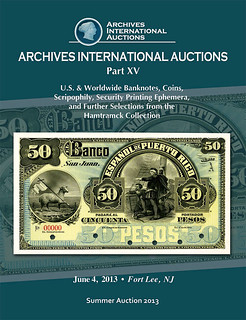
Rare U.S. & Worldwide Banknotes, Coins Scripophily and Security Printing Ephemera Including Additional Selections from the Hamtramck Collection, another offering from the American Bank Note Commemoratives Inventory as well as Properties of Banknotes, Coins and Scripophily from various consignors.
and Security Printing Ephemera Including Additional Selections from the Hamtramck Collection; The Somerset Collection as well as distinguished
Properties of Banknotes, Coins and Scripophily from various consignors.
June 4th, 2013 at our offices in Fort Lee, New Jersey
Included will be over 1,000 lots of Rare Worldwide Banknotes,
Coins, Scripophily and security printing ephemera.
Please view our website for auction updates
1580 Lemoine Avenue, Suite #7
Fort Lee, NJ 07024
Phone: 201-944-4800
Email: info@archivesinternational.com
WWW.ARCHIVESINTERNATIONAL.COM
THE DAVID FORE COLLECTION PART TWO
BRITISH INDIAN COINS TO MAKE NUMISMATIC HISTORY Baldwin’s are delighted to present part two of the most impressive collection of Indian coinage ever to be sold by public auction. Due to be held on the 31 May at the CIPFA Conference Centre in London the auction will contain 291 lots of Patterns and Proofs of British India, the Presidencies and the Indian Native States.
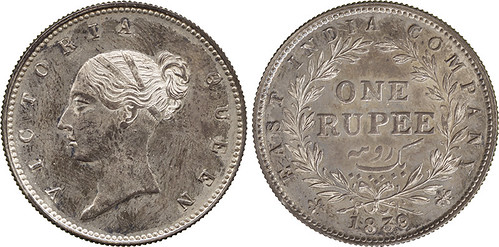
Lot 796, a Silver Pattern Rupee of 1839, crafted by an unidentified Indian engraver at the Bombay mint, is perhaps the most important piece of the entire collection. Very little is known about the coin with Pridmore only able to add that it was submitted to the Supreme Government in 1839, but rejected. The only additional information that can be derived from his writings on the History of the East India Company is that the engraver at the Bombay mint in 1838 was Jewram Shamji. An early 20th century catalogue of the coins in the Calcutta mint states that two of these patterns reside there but it is unknown if they are still in-situ at the museum. This auction offers a superb opportunity for the buyer of the coin to become part of numismatic history as the owner of one of the most important coins of British India. This impressive coin carries an estimate of £60,000 – 80,000.

In amongst the other items in the sale are some of the most exciting offerings from the British Indian series ever to have been offered at public auction. Lot 748, a 1904 Copper Pattern ½-Anna, is one of only three examples known to exist. Of the three, lot 748 and a second specimen, from the Norman Jacobs Collection, are the only two available to private collectors. The third is housed in the Calcutta Museum. The minstmaster was clearly thinking ‘outside the box’ when he created this pattern, the Rupee die was available as the obverse but a completely new and fresh reverse was made to strike this 31mm coin. This rare opportunity to own a coin of this caliber, in this condition, accounts for the estimate of £20,000 – 30,000.
Caroline adds:
The third part of the collection is due to be sold on the 26 September as part of Coinex, the UK’s largest numismatic fair, of which Baldwin’s are the official auctioneer.
I have sadly seen the latest edition of The E-Sylum - could you reassure your readers that I’m not as scary as I look?!
For more information on Baldwins and the Fore sales, see: www.baldwin.co.uk
GERMAN CHILDREN USING INFLATION MONEY AS BUILDING BLOCKS
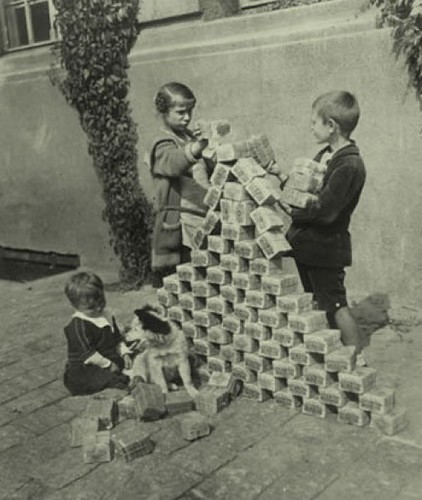
To read the complete article, see: German children using marks as building blocks (semioticapocalypse.tumblr.com/post/49759737969/german-children-using-marks-as-building-blocks#.UY0y7LWNqXi)
FEATURED WEB PAGE: THE NUMISMATIC MALL
This week's Featured Web Page is suggested by John W. Adams: John Lupia's Numismatic Mall.The Numismatic Mall was created in 2011 by John N. Lupia, III to promote research in numismatic history. Currently, this site is under construction. Check in from time to time since new entries and articles will be posted continuously. The main features of this site are The Encyclopedic Dictionary of Numismatic Biographies, The History of Collecting, The History of Numismatic Literature, Index to Mason's Coin Collectors' Magazine, The House of Bangs, and The Chapman Family Dynasty.
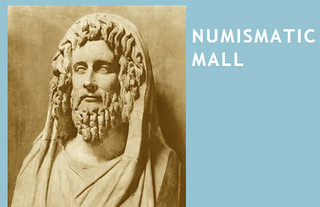
https://sites.google.com/site/numismaticmallcom/

